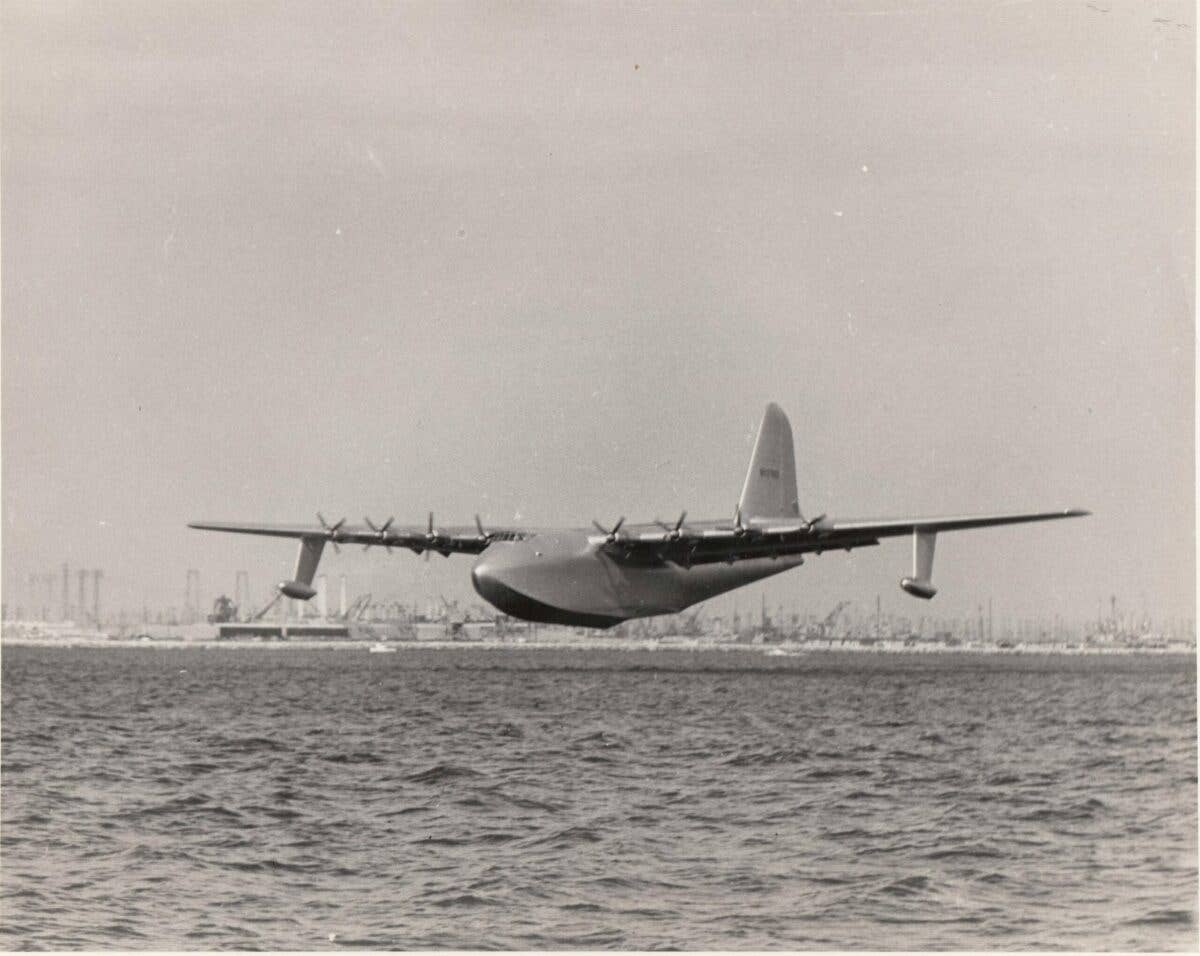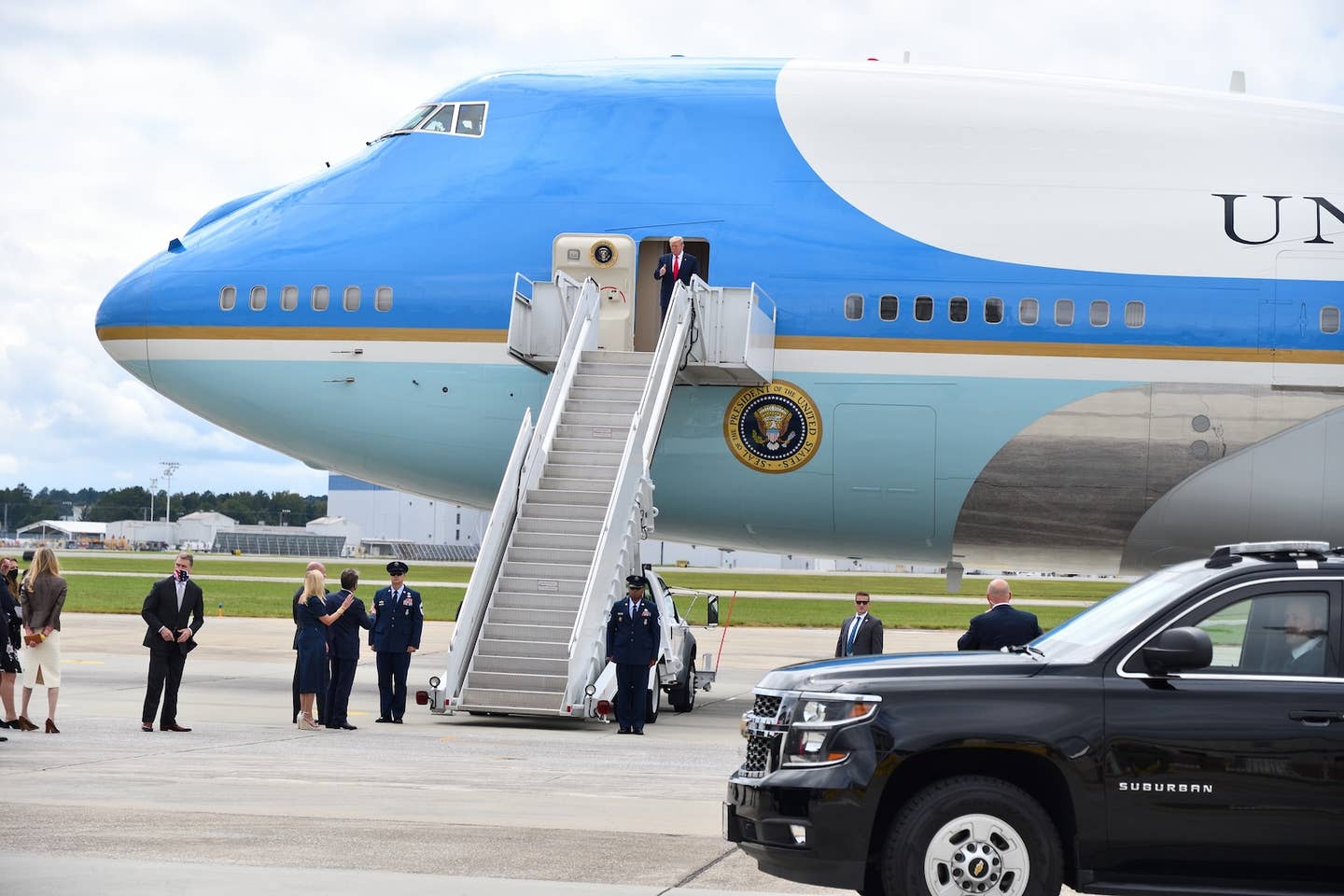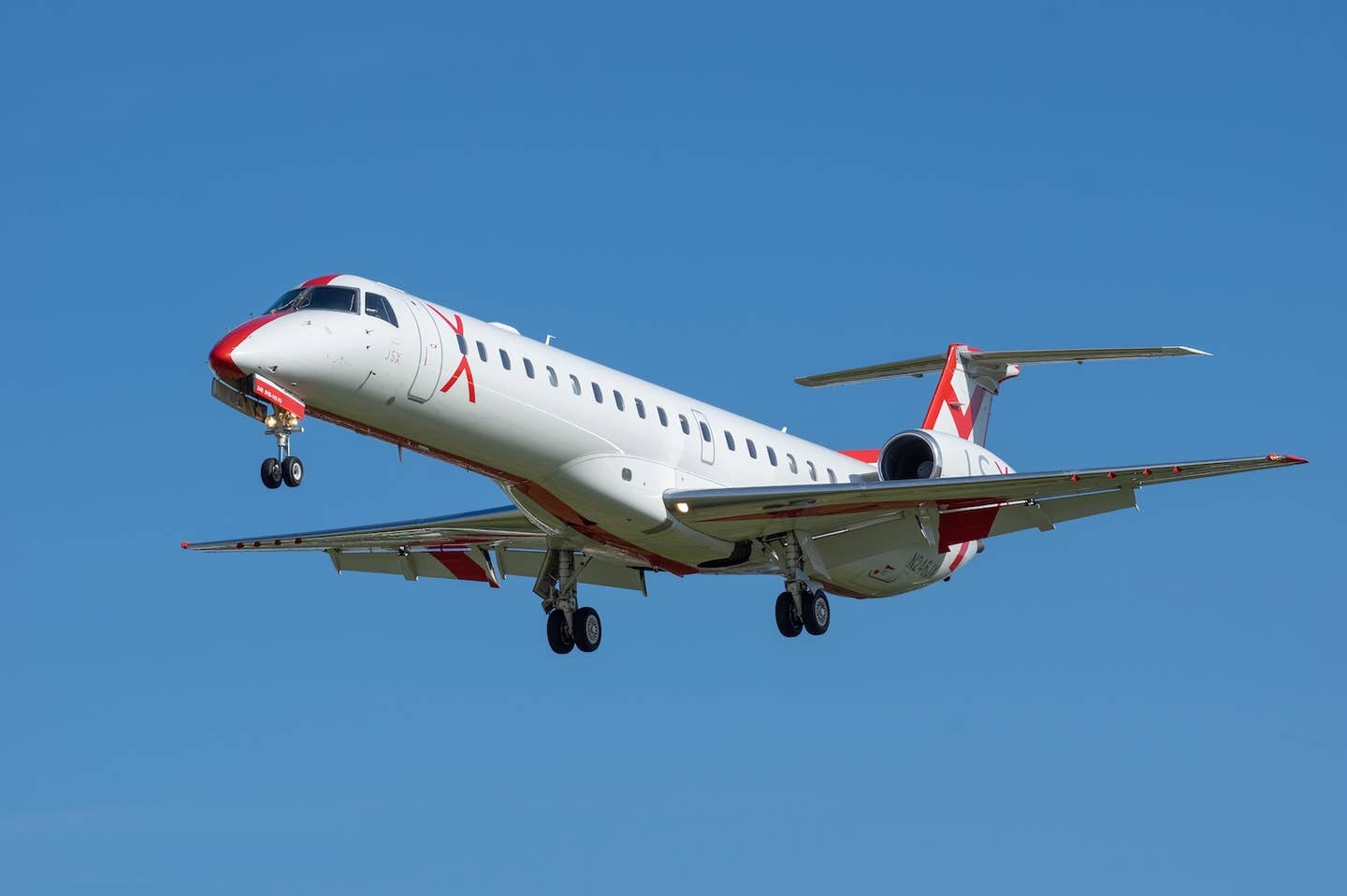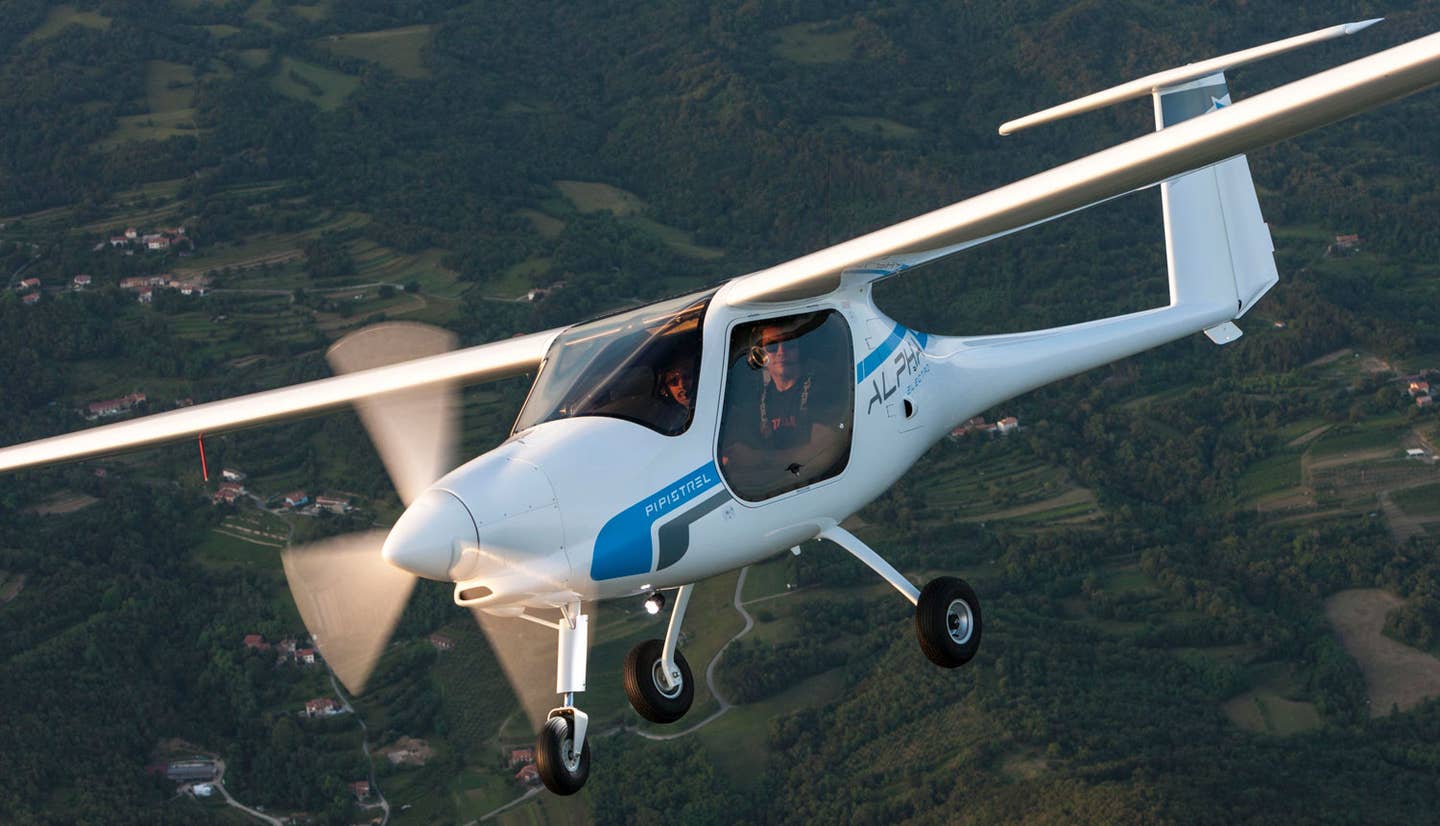When the ‘Spruce Goose’ Took Flight
Howard Hughes’ giant wooden seaplane took its first flight 75 years ago.

November 2, 2022, marks the 75th anniversary of the one and only flight of the Hughes Flying Boat, the so-called ‘Spruce Goose.’ [Courtesy: Evergreen Aviation & Space Museum Collections]
November 2, 2022, marks the 75th anniversary of the one and only flight of the Hughes Flying Boat, the so-called Spruce Goose. The massive machine is the crown jewel of the Evergreen Aviation & Space Museum in McMinnville, Oregon. The one-of-a-kind aircraft is the centerpiece of the museum in a building that was—quite literally—designed around it. And you better believe the museum is celebrating the 75th anniversary.
The Hughes Flying Boat
The aircraft was first conceived during World War II, when there was a growing need to get men and supplies over to England and Allied ships were being sunk at an alarming rate by German submarines.
In 1942, Henry Kaiser—a steel magnate and shipbuilder—came up with the concept of a giant seaplane to transport men and supplies. He enlisted the help of Hollywood producer and aircraft designer Howard Hughes. At the time, aluminum and steel were considered strategic materials needed for the war effort, so this aircraft had to be designed from non-strategic materials, such as wood.
It was constructed of Duramold, a composite material made of birch and resin, which is then laminated together.
The aircraft was originally designated as the HK-1, but when Kaiser dropped out of the project in 1944 due to frustration over construction delays, the behemoth aircraft was re-named the H-4 Hercules.
Delays would continue and the aircraft was not completed until 1946 after the war had ended. The aircraft cost $23 million to build, or about $352 million in 2022 dollars.
The name Spruce Goose was a pejorative nickname given to the project by Hughes' critics. It was said that Hughes hated the name, as he thought of the aircraft as an engineering marvel, not to mention the aircraft was not constructed from spruce.
(Historians would later note that some of the men who worked on the airplane allegedly referred to it as The Birch Bitch, so perhaps Hughes accepted the lesser of two evils.)
The size of the price tag, not to mention the size of the airplane itself, raised eyebrows in Congress, as lawmakers who had allocated the funds for the airplane demanded proof that it could actually fly. The first step was to conduct taxi tests for the mammoth seaplane.
Thousands of people and scores of journalists turned out to watch the flight on November 2, 1947. Hughes was at the controls as he took the H-4 from its berth in Long Beach into the harbor. On board were dozens of crew members, along with a significant number of journalists from both radio and newspapers. Many more stood on the shore watching the spectacle.
Hughes made two taxi passes, keeping the aircraft below its 95 mph lift-off speed. On the third pass, he accelerated, allowing the aircraft to lift off.
“Two hundred tons are airborne!" crowed the newsreel announcer as the aircraft in the flickering black and white footage cruises over the water.
The aircraft flew for approximately one mile at an altitude of approximately 70 feet over the water. When Hughes was asked if the 30-second flight was intentional, he replied, “Certainly. I like to make surprises.”
After the Flight
The H-4, however, never entered production and never flew again.
Hughes had the aircraft moved into a climate-controlled hangar in Long Beach Harbor. It was off limits to the public. Despite this, until the end of his life, Hughes had standing orders that the aircraft was to be kept “one phone call away” from flight.
The annual cost to mothball the airplane was $1 million, which included the salaries of the people whose job it was to keep the aircraft ready to fly. There were people who spent their whole career caring for an aircraft that never left the ground.
After Hughes’ death in 1976, the lease on the hangar expired and plans were made to dismantle the aircraft. Summa Corporation, Hughes' holding company, wanted the aircraft to be divided up so components of it could be sent for display in several aviation museums.
The Aero Club of Southern California and the Wrather Corporation, which managed outdoor exhibits in Long Beach, California, such as the Queen Mary, stepped in to thwart the plan. The H-4 was removed from the hangar and transported by barge to Long Beach, where it became a tourist attraction next to the Queen Mary. The aircraft was placed under a large shell and put on display for the public. As the 1980s drew to a close, the Spruce Goose as it was now known had been sold to the Disney Corporation, and was now in need of a permanent home.
In 1992, Michael King Smith and his father Delford M. Smith, founder of Evergreen Aviation, founded the Evergreen Air & Space Museum and submitted the winning proposal to provide a home for the Spruce Goose. Both father and son were accomplished pilots and wanted to preserve the iconic airplane.
Years in the salt air under the shell had taken their toll. Smith's plan called for the aircraft to be relocated to McMinnville, Oregon, where Evergreen Aviation was located. The Spruce Goose would become the centerpiece of an aviation museum.
The Big Move
The aircraft was disassembled, and the fuselage, control surfaces, wings, horizontal stabilizers and vertical tail were carefully shrink-wrapped to protect them. The disassembly took six weeks and left the airplane in 38 pieces. There were, however, a few surprises along the way. When the massive tail was pulled off the empennage, for example, it let go with a loud "pop!" like a champagne cork. The engines and propellers were also wrapped and shipped by truck.
A hole had to be cut in the shell so that the rest of the aircraft could be loaded onto barges for its journey up the West Coast. It would travel up the Columbia and Willamette Rivers to Portland, Oregon. From there, it would be trucked to McMinnville some 50 miles away.
The conditions had to be perfect for the barges to negotiate the rivers. If the water level was too high, the barges could not pass beneath the bridges. It took several months for the barges to travel the distance to the location where the Spruce Goose was placed on flatbed trucks for the last 50 miles of the journey.
The last part of the journey was well documented, as people lined the streets. The pace was slow and methodical. In certain places street signs and telephone poles and wires had to be removed so the trucks with their bulky cargo could make it safely down the road. The entire trip took 138 days.
Restoration Begins
The first stage of restoration was accomplished over several months in a temporary facility at Evergreen Aviation at McMinnville Airport (KMMV). While the aircraft was restored, the museum, located about 800 feet away across the road, began to take shape. Sadly, Michael King Smith would not live to see the museum open. He was killed in a car accident before the building was completed. His father insisted on continuing the project.
On September 16, 2000, the aircraft—still under restoration—was painstakingly and slowly moved across the road to the museum. The work on the aircraft continued as paint was stripped, the skin re-sanded and the control surfaces reskinned.
When the museum officially opened on June 6, 2001, the Spruce Goose was in the center of the building, but not completely together. Its flight control surfaces were still undergoing restoration. The final assembly was completed on December 7, 2001.
The Spruce Goose Reigns Supreme
Today the Spruce Goose is one of 108 aircraft on display at the museum. It sits in the center of the building, its keel countersunk about seven feet into the floor.
The airplane is so large, according to the museum Curation & Collections Director Lydia Heins, that some visitors don’t realize they are looking at an airplane when they first lay eyes on it. After a few minutes, the sheer size of it registers, and they take it in, with some even venturing inside the mammoth aircraft.
"The cargo hold is available to enter and view with general admission to the museum, and visitors can take a guided tour of the flight deck with an additional ticket," Heins said, adding, "For the 75th anniversary year, we are workshopping new ways to enhance the aircraft experience for guests using more modern exhibitry tools available while preserving the integrity of this historic artifact."
According to Heins, the museum staff are careful to protect the integrity of the artifact, as it is sensitive to climate conditions and external contaminants. Of particular concern is sun exposure, which degrades the composition of Duramold, as well as humidity, and extreme temperature fluctuation. The museum's mission is to keep the airframe healthy enough to keep it on display.
"We are raising money during the 75th anniversary year to investigate supports for the wings and tail as the aircraft and Duramold material ages," Heins said. The museum is focused on preserving the mechanical components and, "exploring what it would take to restore the Flying Boat to its original condition before it was placed on display in Long Beach," she added.
Dispelling Rumors
There are some wild stories out there about the Spruce Goose, according to Heins, among them that the Spruce Goose has termites (not true), that the engines are fired up annually (not true), or that there is more than one Spruce Goose (so not true).
None of that is true, Heins said, adding that the termite reference was someone's idea of an April Fool's joke online that went viral. Termites are not an issue because the combination of preservation practices and the aircraft's Duramold construction, which is essentially a chemically processed wood product, make the Spruce Goose unappetizing to the insects.
Hughes, who was renowned for his eccentricities, was also known for his engineering skills. As part of its collection, the museum is in possession of the technical data for the Spruce Goose. The material came to the museum "with more than a million pieces of paper about the fabrication and construction of the airplane," Heins said. "We call that collection of documents the Hughes Archives, and it consists of original concept designs, original engineering drawings of every part of the aircraft, photographs and moving images, and testing reports."
The Movie Connection
In 2003, when the Hughes' biopic, The Aviator, was in production, movie production staff visited the museum several times as they worked to design and build sets for the all-important Spruce Goose flying scene.
The museum staff worked with set designers that built the full mockup of the flight deck, which required the recreation of the flight stations down to the levers and dials.
"The movie costume crew also visited the museum for information about the types of clothing worn by the workers who constructed the Flying Boat," Heins said. "The color historic film footage also came from the museum’s collection."
After the release, the miniatures that were used in the production of the movie were donated to the museum and are currently on display.

Sign-up for newsletters & special offers!
Get the latest FLYING stories & special offers delivered directly to your inbox






